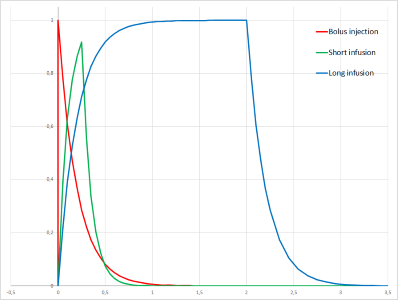Graham's compartmental model for input function
Compartmental models for arterial input function (AIF) have been developed for PET data analysis and simulation, specifically for [15O]H2O studies (Maguire et al., 2003), and a general AIF model for PET was presented by Graham (1997):
In this model the radiopharmaceutical is introduced directly into the plasma compartment, and therefore, instead of the boxcar function often used to represent infusion, Graham simulated the bolus injection and bolus infusion with functions that include exponential terms. The exponentials represent the initial dispersion that distorts the bolus shape before it enters the arterial network for the first time. Bolus injection was simulated with simple decaying exponential with time constant ki:
, where H represents the amount (radioactivity) of injected radiotracer (Figure 2), with units of radioactivity/time. Longer bolus with infusion duration Tdur was simulated with boxcar function including exponential terms on both leading and trailing edges:

Definite integrals of the inputs for Graham's compartmental plasma model, when considering not only the duration of infusion Tdur but also the start time of bolus/infusion Ti, are for the short bolus:
, and for the infusion:
Differential equations for the Graham's compartmental model are (Graham, 1997):
The ordinary differential equations for discrete data can be solved practically using the 2nd order Adams-Moulton method, based on implicit Euler integration of the nth compartment:
, where Δt is the time between two samples. To shorten the equations, we will below use term En for the part that only contains data from previous data points:
and thus
Substitution of these into the equation for CTF gives equations
These equations can be used to solve CIF and its integral:
and with these, CP:
The Graham's model depicts slowly varying plasma activity over several minutes, but is not intended to model the first-pass kinetics and recirculation effects with radiotracers such as [15O]H2O. As Graham points out, all compartmental models will have a simple exponential behaviour at late times, although many radiopharmaceuticals tend to have a slight upward convexity long times after injection. This model cannot account for this phenomenon, nor the appearance of label-carrying metabolites in the blood or plasma. Compartmental model for metabolite correction was developed by Huang et al. (1991), and Graham (1997) suggested combining the compartmental models for plasma curve and metabolites. Graham et al (2000) used his compartmental model for smoothing and interpolating TACs from aorta in a FDG study to construct a population-based input function. Spence et al (2008) used the method to extrapolate metabolite-corrected blood TAC in a [18F]FLT study.
In a slightly expanded version of the Graham's compartmental model the blood (or plasma) compartment is separated into two compartments, arterial (BA) and venous (BV) (Figure 3). This adds dispersion that happens in the pulmonary circulation to the modelled arterial blood curve. Radiotracer is administered to the venous compartment, which accounts for the initial dispersion of bolus infusion, and therefore the infusion can be simulated using simple rectangular (boxcar) function. Tissue compartments are in parallel, not in series; kinetically the parallel model is indistinguishable from the model with compartments in series, but differential equations for the parallel model are simpler.
Differential equations for the compartments in the extended model are
The integrated forms of the ordinary differential equations for discrete data can be solved as above, giving equations
Integral for the boxcar function used to represent the infusion, starting at time Ti and lasting for time Tdur, can be calculated as
Parent radiopharmaceutical could be metabolized in the tissues (TS and/or TF) and/or in the circulation (BV and/or AV). While metabolism and subsequent removal of the metabolite(s) from circulation can be accounted for by the rate constant kU in the model above, removal of parent tracer into metabolite pool in other compartments can only be accounted for by adding rate constants for the metabolism rates (Figure 4):
Differential equations for the parent radiopharmaceutical compartments in the extended model, including escape via metabolism, are
The integrated forms of the ODEs for discrete parent radiopharmaceutical concentrations are
Although the model is shown like the metabolites from in the tissue compartments or in the venous and pulmonary system would return to the BV compartment, this model only accounts for the disappearance of the parent radiopharmaceutical via metabolism, but does not actually consider the fate of the labelled metabolite. However, the metabolites formed in this model setting could be used as input for compartmental models describing the plasma kinetics of the metabolites.
See also:
- Compartmental models for input function
- Compartmental models for metabolite correction
- Fitting compartmental models
- Input for simulations
- Blood sampling
- Input function
- Modelling A-V difference
- Plasma pharmacokinetics
References
Graham MM. Physiologic smoothing of blood time-activity curves for PET data analysis. J Nucl Med. 1997; 38(7): 1161-1168. PMID: 9225813.
Tags: Input function, Fitting, Compartmental model, Extrapolation
Updated at: 2019-05-26
Created at: 2003-03-30
Written by: Vesa Oikonen